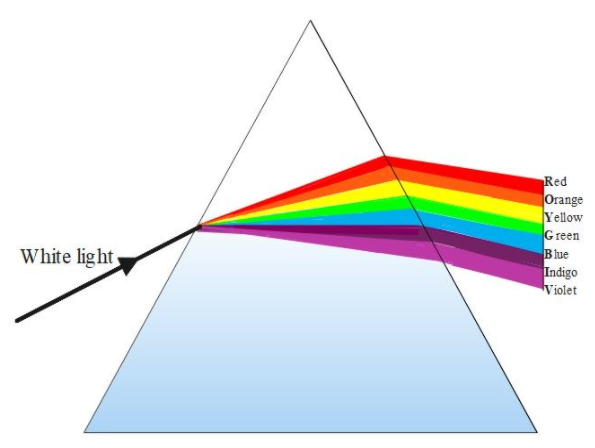
What is dispersion? Which color gets dispersed the most?
Answer
549.9k+ views
Hint: Dispersion is the phenomenon where the white light is separated into different colors of light according to the wavelength. Usually, the color with less wavelength will disperse the most and the color with highest wavelength will disperse the least.
Complete answer:
Dispersion phenomenon is the process of separation of white light into different colors. We all know, the wavelength of the light is inversely proportional to the deviation in the path of a light. We know, in the colors VIBGYOR, the red is having the highest wavelength while violet will be having the least wavelength. We can conclude that, the violet, will be deviating the most as it has the least wavelength. Whereas, the red color, which is having the highest wavelength, will disperse the least.

Additional information:
The most common example of the dispersion phenomenon that we see in our daily life is the Rainbow. Rainbow forms after a rainfall and only when the sun is also present. The water droplets in the clouds will get dispersed due to the sunlight falling on them. This results in the beautiful scenario. Dispersion includes the refraction first, then internal reflection and refraction again. Some of the artificial ways to produce dispersion is passing light through a prism. Prism also behaves just like a water droplet and it allows the light to get separated into different colors.
Note:
If the light entering the prism is not a combination of different wavelengths, we cannot experience splitting of different light. If the light is monochromatic, there will not be any dispersion phenomenon taking place. The main cause of dispersion is the deviation angle of different light.
Complete answer:
Dispersion phenomenon is the process of separation of white light into different colors. We all know, the wavelength of the light is inversely proportional to the deviation in the path of a light. We know, in the colors VIBGYOR, the red is having the highest wavelength while violet will be having the least wavelength. We can conclude that, the violet, will be deviating the most as it has the least wavelength. Whereas, the red color, which is having the highest wavelength, will disperse the least.

Additional information:
The most common example of the dispersion phenomenon that we see in our daily life is the Rainbow. Rainbow forms after a rainfall and only when the sun is also present. The water droplets in the clouds will get dispersed due to the sunlight falling on them. This results in the beautiful scenario. Dispersion includes the refraction first, then internal reflection and refraction again. Some of the artificial ways to produce dispersion is passing light through a prism. Prism also behaves just like a water droplet and it allows the light to get separated into different colors.
Note:
If the light entering the prism is not a combination of different wavelengths, we cannot experience splitting of different light. If the light is monochromatic, there will not be any dispersion phenomenon taking place. The main cause of dispersion is the deviation angle of different light.
Recently Updated Pages
Master Class 11 Economics: Engaging Questions & Answers for Success

Master Class 11 English: Engaging Questions & Answers for Success

Master Class 11 Social Science: Engaging Questions & Answers for Success

Master Class 11 Biology: Engaging Questions & Answers for Success

Class 11 Question and Answer - Your Ultimate Solutions Guide

Master Class 11 Business Studies: Engaging Questions & Answers for Success

Trending doubts
10 examples of friction in our daily life

One Metric ton is equal to kg A 10000 B 1000 C 100 class 11 physics CBSE

Difference Between Prokaryotic Cells and Eukaryotic Cells

1 Quintal is equal to a 110 kg b 10 kg c 100kg d 1000 class 11 physics CBSE

Explain zero factorial class 11 maths CBSE

What is a periderm How does periderm formation take class 11 biology CBSE




